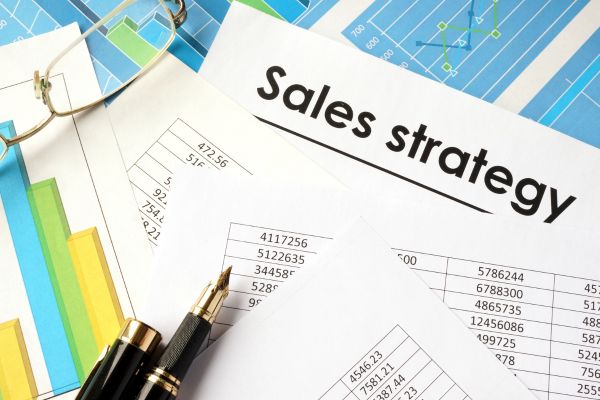Sales strategy is essential for growth for SMEs. Your sales strategy is your detailed plan on how to best reach new prospects in your target market in a way that maximises the chances of them becoming your valued customers.
The sales strategy will depend on what you’re selling and who your target customers are. Another factor will be how much resources you have. If you’re a larger company you can run broad and expensive marketing campaigns as part of your sales strategy.
For most companies that is not a viable option.
Some companies – and marketers – swear by the inbound sales route where their sales strategy does not involve approaching new prospects but rather having new customers finding out about your products by themselves and contacting you directly.
That’s awesome if you can make it work but few are so successful with this sales strategy that they can rely on it.
This article focuses on sales strategies for companies with limited resources and on strategies that rely on direct outbound sales. For most that are looking for stable and predictable sales results, they should build a sales strategy where you stay in control of the entire sales process.
This article will also be most relevant for companies selling B2B although you should pick up some useful information if you’re selling B2C as well.
So let’s get started.
Sales Strategy in 3 easy steps
To make everything nice and easy we’re going to discuss a sales strategy that simply involves:
It shouldn’t be harder than that and we’re going to outline an exact method, sales strategy, that will work for most SMEs selling business-to-business.
This is basically how we do sales – and how many of our clients do sales – and it may very well work for you as well.
The first step in your Sales Strategy – Finding the right Prospects

With the growth of social media and online searches, finding the right prospects to target has probably never been easier.
However – engaging them is probably getting harder and harder as business leaders are growing more immune to online advertisements.
Studies have shown that businesses have changed their buying behaviour drastically in the last decades. They have already almost made their buying decision when they are talking to a salesman. They have done all the research, know all your competitors, and the salesperson faces a difficult task altering their decision at this stage.
That’s why the Challenger sales strategy has risen in popularity. Customers are willing to engage with salespeople that challenge them with new ideas that they have not thought about themselves. But it’s often too late to challenge them with your great suggestions when they’ve already made their buying decisions.
So you need to engage them at an earlier stage with your radical new idea.
In our case, it would be to go for independent sales agents instead of hired sales employees.
Here’s the sales strategy that is working for us, and many others, in this crucial first step
We target industries that are in the market for our products. We find out who their decision-makers are. And we send them a personal e-mail challenging them to consider our approach to sales agents.
Doesn’t really sound that easy, does it?
How on earth are you going to find all the decision-makers in your target industry and then find the time to send a personal e-mail to each of them?
Unless you have the money to hire a team of lead generators it doesn’t sound like a realistic first step of a sales strategy.
Luckily for us – and others – it’s possible to outsource this entire operation. SoPro does this part on our behalf and their service is affordable, easy, and extremely effective.
They find the companies (based on your target criteria) and their decisions makers. They help with writing an engaging and personal e-mail that will end up in the inbox of your potential new customers.
All you have to do is take care of the rest of the process when you receive replies.
If you would like more details of this part of our sales strategy you can contact SOPRO directly for a demonstration.
The second step in your sales strategy – Engaging your new clients
If you follow our method in step one this part is already taken care of. Your target clients are receiving a personalised e-mail written by professional copywriters to maximise the chances of a response.

If you don’t outsource the lead generation part of the process you’ll either need to have internal staff finding prospects or another option would be to leave it to the sales agent.
In some instances it makes perfect sense to just let the sales agent do the sales process from start to finish. For example if you’re selling to a highly targeted and specialised market it makes more sense to let the sales agent also do the lead generation part of your sales strategy.
The lead generation strategy that we’ve outlined above works best if you have a product or service with a huge market. The more niche your market is the more you should consider an alternative strategy for the first steps.
The third step of your sales strategy – Dialogue and closing

We’re not going to talk about sales techniques in this article. How to actually handle the dialogue and getting the sale is something that your sales representative should know. We’ve also already written an extensive article on specific techniques on how to close sales.
As a business owner it’s however essential that you have qualified and professional salespeople to take care of this process. This is our expertise and we’ll therefore dwell a bit on how to find the right salespeople for your company.
Sales strategy – To hire or not to hire
All hires are important, but it can easily be argued that making the right choices in hiring the right salespeople is more important than anything else.
If you don’t have salespeople who generate enough revenue it’s difficult to pay for other employees or run the company.
Some will object to this and say that an alternative is to become so good at Inbound Marketing that salespeople become redundant. We are also supporters of Inbound, outbound, or any other form of marketing, but in the real world, there is still a need for salespeople to make things happen. Very seldom will leads close themselves.
So for the vast majority of executives who realise that salespeople are important, there are three routes to go down:
- Employ your own salespeople
- Outsource the sales with sales agents.
- A combination
What’s the right sales strategy for your company. Let’s discuss the options in more detail:
The traditional method: Employed salespeople
As with many other things, it involves both advantages and disadvantages. The clear advantage is that it gives you as an employer more control by managing directly the salesperson you hire and their activity. Some people also prefer to be permanently employed rather than working as an independent salesman and you will usually have more candidates to choose from. This is definitely an advantage, but at the same time be aware that the quality of the candidates does not necessarily increase – in fact the opposite can be true.
Once you put a good fixed salary on the table with additional commissions and permanent employment, you’ll probably not lack candidates.
However, you run the risk of having a huge expense if the person you go for doesn’t deliver the results you were looking for.
Many are not aware that there is an alternative by working with independent sales agents as part of their sales strategy. That reduces your economic risk significantly as you only pay for results.
The new sales strategy: Working with independent sales agents
First, we should admit that we’re a bit biased here. Salesagents.uk is the leading portal to find independent sales agents in the UK so keep that in mind as you’re reading this. We do however objectively believe that the case for using sales agents as part of your sales strategy is very strong.
There are several benefits:
- Sales agents are often very skilled sales professional. It takes something very unique for a salesperson to start their own business and be successful long term as a sales agent.
- Agents can be a shorter way to decision-makers as they often already work with clients in the businesses’ target audience
- Much Less financial risk. Normally sales agents work on commission only.
- Less travel expenses with locally-based agents
Disadvantages also exist:
- Less control. As mentioned above you’re not the “line manager” of the sales agent the same way as you’re with a person you employ. So if you implement independent agents as a sales strategy you should treat the agent more as a “sales partner” rather than an employee.
- More scepticism from candidates. An agent is only interested in selling a product that actually is sellable. Remember that you’re asking someone to work on commission-only. They are only interested in that if there is an upside to them. If they’re not convinced that your product is viable you will struggle to find sales agents. If you work with Salesagents.uk our professional copywriters will assist you in making your product/service as attractive as possible to professional sales agents, but your products of course still need be viable in the market. If you have a track record of sales, an innovative product, or a clear competitive advantage you should be fine.
A combination
It’s certainly also an option to use a combination of both employed salespeople and independent sales agents. This is a growing trend especially for sales in areas that are far from where you’re based. It’s both costly and tedious for salespeople to travel long distances to meet prospects and clients. A much better option can then be to work with locally-based sales agents.
Some numbers you need to consider for your sales strategy
If you’re a growing SME with financial and sales targets you’ve probably got an idea of how many sales your strategy will need to provide in the next 12 months to achieve your targets.
If you have a revenue target but not a sales target, convert it into product sales by dividing the monetary target by the revenue generated from one average sale. This will tell you how many sales you will need to be closed to hit your target. The number may appear a reasonable goal; but watch what happens next as we drill down to each stage of your sales strategy.
How many prospects do you need to engage with?
How many prospects does your sales strategy need to get to the engagement stage for you to hit your sales target? If you’ve never thought about this before, make your best estimate now.
To accurately calculate the number of prospects you need to engage with, think about how many prospects you talk to that convert to closed sales. If you get 10 prospects to the point where you present your sales offer, how many usually become paying customers? In our business the average figure is around 2 in 10. On average, we need to engage with 5 prospects to generate one closed sale.
Now take your average number of engaged prospects needed to generate one sale and multiply by your sales target we discussed above. If your engaged prospect number per sale is 1 in 5 and your sales target is 300 sales, you will need to engage with 1,500 prospects to achieve your target.
Doing this calculation is really useful for SMEs creating a sales strategy. It gives you a picture of the scale of the task and the numbers involved. This isn’t the whole picture though, there’s more shocking figures.
How many prospects do you need to find?
The engaged prospects will come from the actions you take to find them in the first step of the sales strategy, Finding Prospects. So, how many potential prospects do you need to contact in step 1 to generate your required number of engaged calculated above?
To determine this number you will need an idea of how many potential prospects you contact that you then go on to engage with. This can appear difficult to estimate but if you telephoned or emailed 100 prospects how many would you qualify as prospects and present your sales proposal to? The number will vary depending upon your market sector and how easy it is to target prospects. In our business we may only engage with 10 prospects out of every 100 potential prospects we contact through our lead generation partners. On average, we need to contact 10 potential prospects in step 1 of our strategy to generate 1 qualified prospects that we engage with in step 2.
When you’ve calculated your number, multiply by it the number of prospects you need to engage with to hit your target, the number we determined in the section above a few moments ago. This is how many potential prospects you need to be contacting to generate enough engaged prospects to convert at your average rate to achieve your sales target.
Do the numbers surprise you?
Most SME principals are shocked by this number. Just to confirm the numbers you are seeing are correct, let’s continue the example from earlier.
If you convert 1 in 5 engaged prospects to a closed sale (Step 3) and your sales target is 300 closed sales in 12 months, you will need to engage with 1,500 prospects (Step 2) to achieve your target.
If you generate 1 prospect from every 10 potential prospects you contact, the number of potential prospects you will need to contact (Step 1) is 1,500 x 10, a total of 15,000.
What the numbers mean for your sales strategy
When an SME gets to the point where they need to increase resources to achieve growth and hit sales targets the numbers above can be a staggering revelation. The good thing is, you are reading this article and gaining an understanding of what your sales strategy needs to achieve at all 3 steps.
It is doubtful that as an SME you have the in-house resources to be able to contact enough potential prospects, engage with the qualified prospects, and close the required number of sales. Only by investing in resources to cope with numbers involved to hit your targets can you hope to achieve the growth in sales that you desire.
Sales strategy – The Conclusion
The entire sales strategy we’ve outlined here can be outsourced. That means that you can have a very low-risk sales strategy where you don’t have all the risk involved with hiring employees and building a lead generation strategy internally. You can focus on developing your product and servicing your customers.
If you like to use commission-based sales agents as part of your sales strategy you can learn more about our service here.
If you have any questions or feedback regarding this article or sales agents in general, you’re welcome to get in touch.


